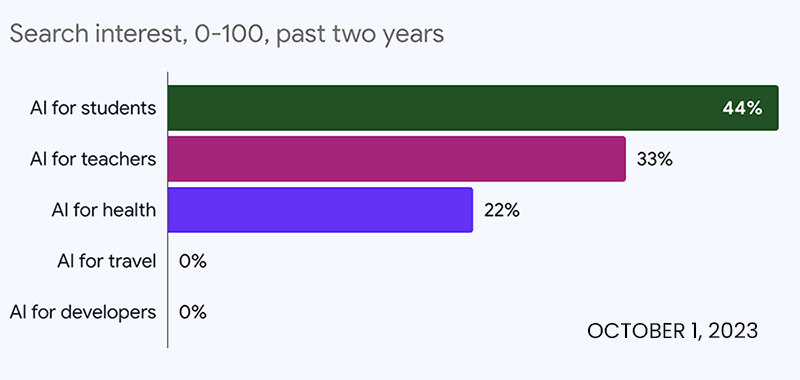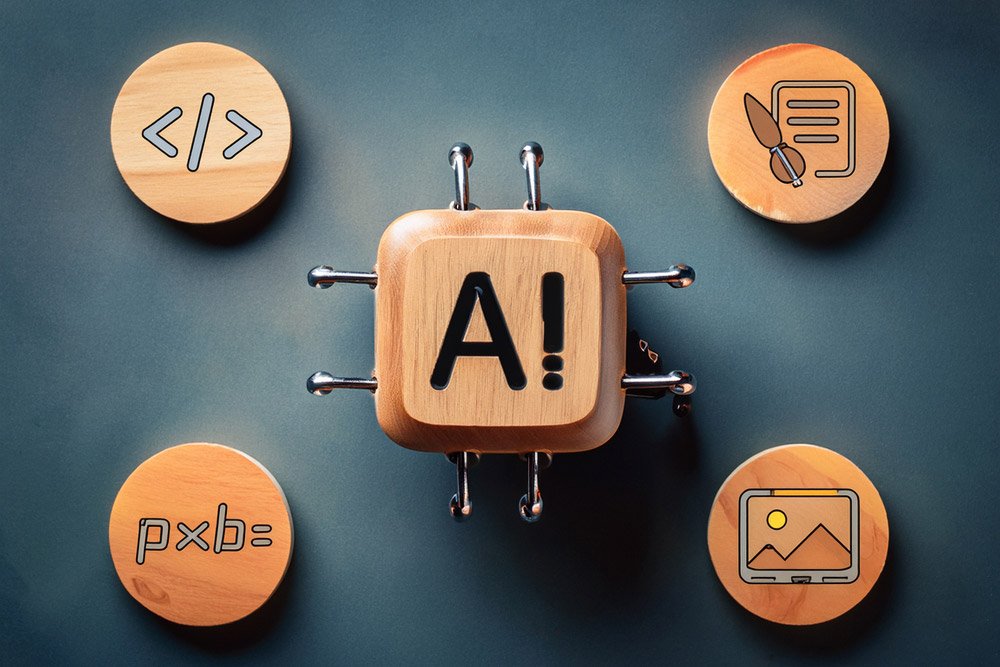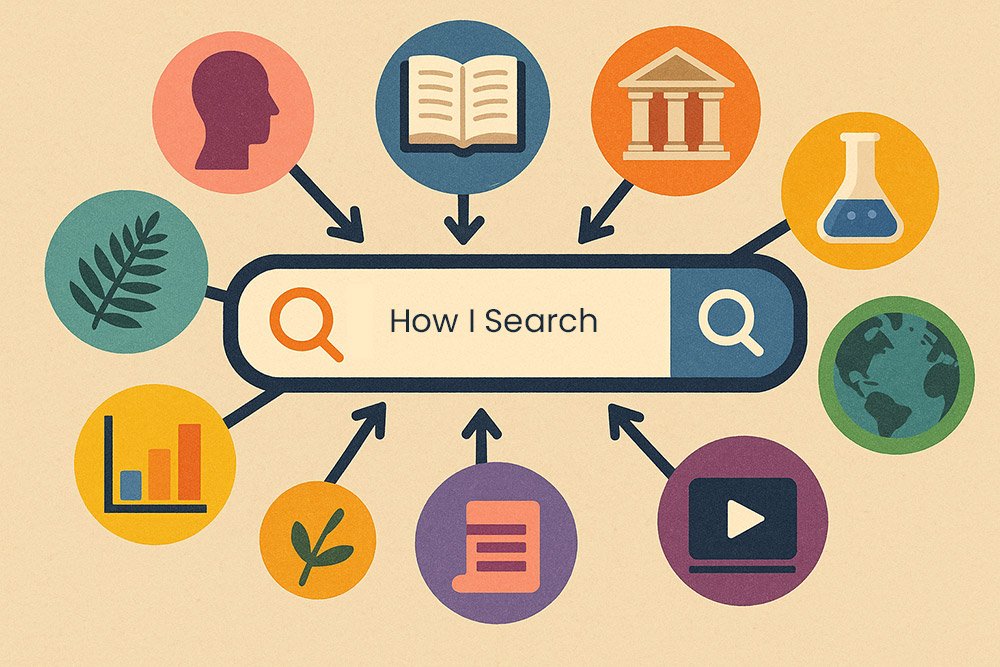Table of Contents
How AI Search Trends Reflect Public Interest
Google’s data on AI search trends reveals a fascinating shift in how people engage with Artificial Intelligence. AI has become one of the defining technologies of our time. From creative tools that generate images in seconds to coding assistants that streamline software development, AI is reshaping how people work, learn, and play.
But how do we know where public interest is heading, and what does it tell us about the cultural adoption of AI? One of the most transparent lenses we have is Google Trends, which tracks what people around the world are searching for.
When we delve into Google Trends data for AI, a captivating narrative unfolds: one of swift evolution, changing priorities, and practical adoption. This rapid evolution is a testament to the dynamic nature of AI and should leave us anticipating what the future holds.
The Evolution of Public Interest in AI
Google’s AI search trends reveals that public interest in AI has followed a clear trajectory.
- The Discovery Phase: In the early years, people wanted to know, “What is AI?” Searches reflected curiosity about a new technology still shrouded in mystery.
- The Application Phase: Today, the most common AI-related searches start with “how to”—as in “how to use AI for writing” or “how to use AI for coding.”
This shift from “discovery to application” is a clear indication that AI is no longer a distant concept. It has evolved into a practical tool that people actively seek to integrate into their daily lives.
The language has also evolved. More and more, people are searching for how AI can “assist” them in coding, writing essays, and solving math problems. This utilitarian focus is a strong sign of normalization: AI is no longer just a buzzword; it’s becoming a familiar partner in productivity.
From “What Is AI?” to “How Can AI Help?”
If you scroll back a few years, the most significant spikes in AI search trends came during breakthrough announcements like when DeepMind’s AlphaGo defeated a human Go champion, or when OpenAI released powerful language models.
Now, instead of abstract questions, Google reveals the top AI search trends are practical:
- “Best AI for coding”
- “Best AI for writing”
- “Best AI for math”
- “Best AI for image generation”
- “Best AI for writing essays”
That last one is particularly telling. A few years ago, the idea of students openly turning to AI for academic help might have seemed controversial. Today, it’s one of the most searched-for applications. However, this trend also raises important ethical questions about the role of AI in education and the potential for misuse or dependence on these tools.
The Top Practical Applications of AI (According to Google’s AI Search Trends)
So what exactly are people using AI for? According to Google Trends, here are the top areas where searches are booming:
1. Coding
“Best AI for coding” tops the list of searches in the United States. Developers, students, and hobbyists alike are turning to AI-powered coding assistants to write, debug, and optimize their work.
That makes sense. Coding is both highly structured and highly repetitive, which are perfect conditions for AI to accelerate productivity.
2. Writing
AI writing tools are second in popularity. They range from professional copywriting assistants to creative story generators. Google Trends shows that, along with inspiration, people want usable text they can refine and adapt.
3. Math
Math-focused AI tools are in high demand, especially for students. Whether it’s solving equations, visualizing functions, or explaining step-by-step reasoning, people are seeking AI support in education.
4. Image Generation
Searches for AI image generation are at an all-time high. Tools like DALL·E, MidJourney, and Stable Diffusion have ignited new waves of creativity, whether for graphic design, marketing, or just for fun.
Interestingly, Google Trends highlights specific niches, such as a spike in searches for “DND image generator,” suggesting that communities (like tabletop gamers) are quickly embracing AI for highly targeted creative uses.
5. Writing Essays
Essay writing has evolved into its own distinct subcategory within the field of writing, which underscores AI’s growing role in education, whether as a study companion, an idea generator, or—depending on how it’s used—a shortcut.
Key Growth Areas Beyond the Top 5
Trends over time
“AI for…” searches compared
October 1, 2023

September 21. 2025

While the top five searches dominate, several emerging trends are worth noting:
- AI and Health: Searches for “AI for health and wellbeing” have gained traction, indicating a growing public interest in how AI can enhance medical advice, mental health support, and lifestyle tracking. However, this trend also raises concerns about data privacy, the potential for AI to exacerbate existing health disparities, and the need for robust regulation in this rapidly evolving field.
- AI in Research: Interest in “AI for academic research” is also rising, reflecting how scholars and students are integrating AI tools into literature reviews, data analysis, and thesis writing.
- AI for Developers: Coding remains a top category, but beyond writing code, developers are exploring how AI can assist with design, testing, and project management.
These growth areas point to a future where AI is not only a productivity booster but also a partner across creative, technical, and even wellness domains.
Geographical AI Search Patterns in the U.S.
Google Trends also reveals how interest in a topic varies across the country.
For example:
- States with strong tech hubs (like California and Washington) show elevated searches for AI coding tools.
- States with robust creative industries (like New York) show more substantial interest in AI image generation.
- Educational searches (like “AI for math” or “AI for writing essays”) are more evenly distributed, reflecting their widespread relevance.
This geographic diversity highlights an important point: AI adoption isn’t one-size-fits-all. Different communities tend to gravitate toward AI tools that align with their local culture, industries, and specific needs.
Why Google’s AI Search Trends Data Matters
Google Trends doesn’t just tell us what’s popular; it gives us insight into the cultural mood.
- The move from curiosity to application suggests AI has crossed the adoption threshold.
- The focus on practical queries (“best AI for…”) shows users want results, not theory.
- Geographic variations reveal how industries, demographics, and interests shape AI engagement.
For businesses, educators, and policymakers, these insights can inform decisions—from what products to build, to what skills to teach, to how regulations might need to evolve.
The Future of AI Search Trends
Looking ahead, several possibilities stand out:
- Specialized AI Niches: Just as gamers search for DND image generators, expect more niche communities to demand AI tailored to their worlds.
- Health and Wellness Growth: As trust in AI for personal health grows, searches are expected to surge, particularly for preventive care and mental wellness.
- Educational Integration: As students increasingly seek AI assistance in writing and math, schools and universities will face growing pressure to establish guidelines.
- Workplace Transformation: As coding searches continue to dominate, AI will likely become a standard tool in professional software development.
Conclusion
Google’s AI search trends data paints a clear picture: the AI conversation has shifted. We’re no longer asking what AI is, we’re asking what it can do for us.
From coding to creativity, from math to mental health, AI has moved from hype to habit. And as search trends continue to evolve, they’ll offer one of the clearest signals of how deeply AI is weaving itself into the fabric of everyday life.






